Navigating the World of Medical Stretchers
A MEDICAL STRETCHER is a specialized patient transport device designed to safely move individuals who cannot walk or sit upright during medical emergencies, hospital transfers, or mortuary services.
Quick Guide to Medical Stretchers:
- Purpose: Safe patient transport and positioning
- Types: Manual, hydraulic, electric, specialty (bariatric, pediatric, mortuary)
- Weight Capacity: Standard (350-600 lbs), Bariatric (up to 1,200 lbs)
- Key Features: Adjustable height, side rails, braking system, safety straps
- Price Range: $22 for basic disposable models to $30,000+ for advanced electric systems
Every day across hospitals, emergency services, and funeral homes, MEDICAL STRETCHERS serve as the critical link in the patient care continuum. These specialized transport devices have evolved significantly from their humble beginnings as simple carrying platforms to sophisticated equipment featuring hydraulic lifts, electric controls, and specialized designs for various medical scenarios.
When selecting a MEDICAL STRETCHER, the primary considerations should include the intended use environment, weight capacity requirements, mobility features, and the ergonomic needs of both patients and caregivers. The right stretcher not only ensures patient safety and comfort but also protects healthcare workers from potentially dangerous lifting injuries.
I'm Mortuary Cooler, and as a national-level supplier with experience in medical transport equipment including MEDICAL STRETCHERS, I've helped countless funeral directors and healthcare facilities select equipment that balances durability, functionality and budget constraints. My expertise spans the full spectrum of patient handling solutions, from emergency transport to specialized mortuary applications.
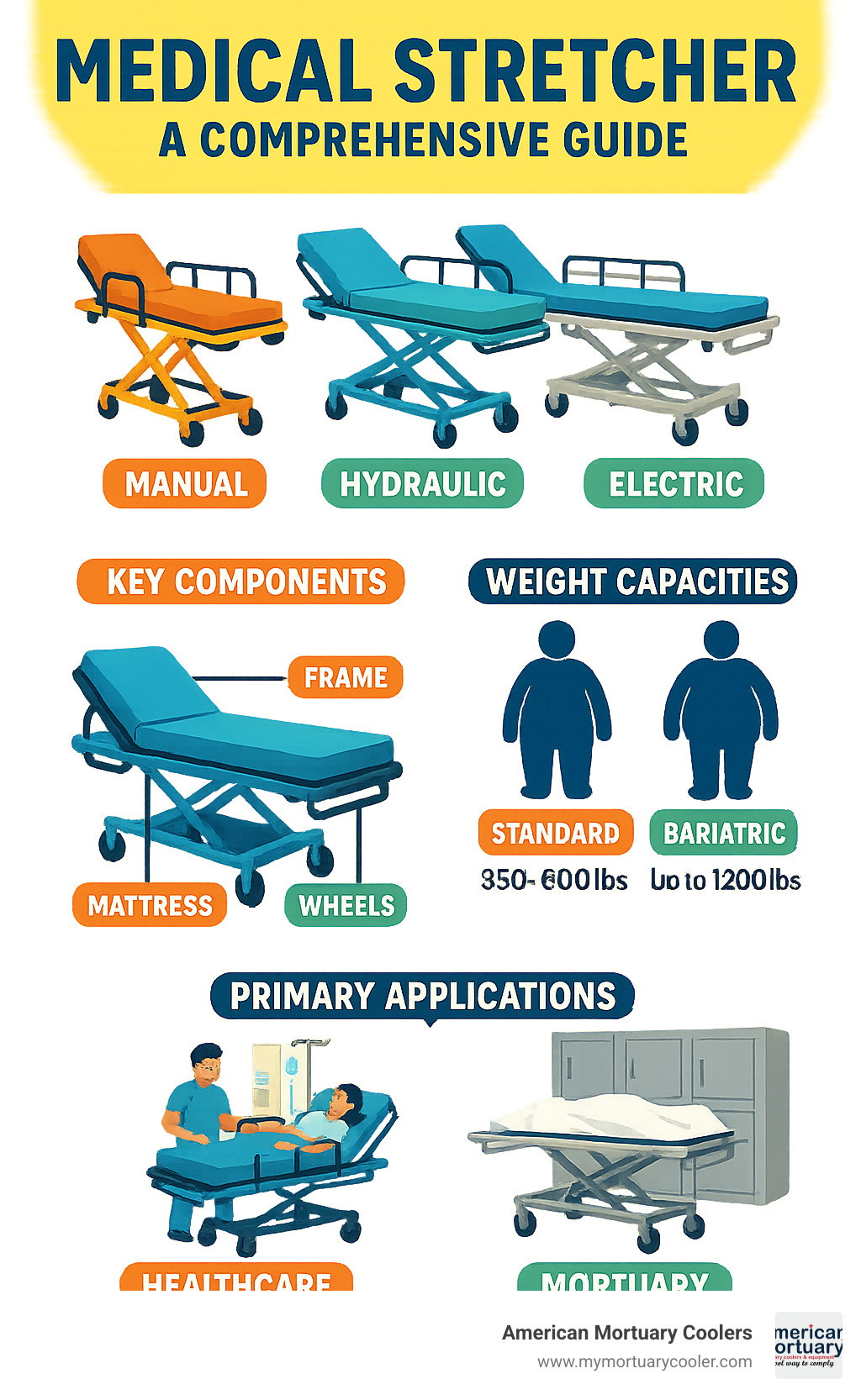
Handy MEDICAL STRETCHER terms:
Understanding the MEDICAL STRETCHER Landscape
What Is a MEDICAL STRETCHER?
When you think about it, a MEDICAL STRETCHER is really the unsung hero of healthcare mobility. At its heart, it's a specialized platform designed to safely transport people who can't move on their own. While many folks use "stretcher" and "gurney" interchangeably (and we're guilty of this too!), there are some subtle differences worth knowing about.
A MEDICAL STRETCHER generally refers to any device that carries patients lying flat, while a gurney specifically means a wheeled stretcher with legs that collapse, perfect for navigating tight hospital corridors. Then there are transport chairs, which keep patients seated upright – great for those who can sit comfortably, but not ideal for patients who need to stay flat.
Every standard MEDICAL STRETCHER comes with several essential components: a strong, reliable frame that provides structural support; a comfortable, padded surface where the patient rests; wheels or casters that make movement possible; protective side rails to prevent falls; secure straps that keep patients safely in place during transport; and in more advanced models, mechanisms that allow for height adjustment.
Here at American Mortuary Coolers, we've witnessed how MEDICAL STRETCHERS have evolved from basic carrying devices into sophisticated transport systems that prioritize both patient dignity and caregiver wellbeing.
Main Types of MEDICAL STRETCHER
The world of MEDICAL STRETCHERS is surprisingly diverse – kind of like how not all vehicles are created equal. Different situations call for different designs:
Ambulance/EMS Stretchers are the road warriors of the stretcher world. They're built tough for emergency transport with features like reliable wheel locks, adjustable height mechanisms, and frames that absorb shock during bumpy rides. They also include special locking systems that keep them secure inside an ambulance when every second counts.
Hospital Stretchers are the indoor specialists, designed for smoother transitions between hospital departments. They feature glide-friendly wheels for indoor surfaces, adjustable backrests for patient comfort, and attachments for IV poles. Many include Trendelenburg positioning – that's the ability to quickly tilt the patient's head down and feet up during emergencies.
Mortuary Stretchers are purpose-built for the dignified transport of deceased individuals. We take special pride in these at American Mortuary Coolers, crafting them with reinforced frames, fluid-resistant materials, and sometimes cooling capabilities. Our focus is always on maintaining dignity throughout the transport process.
Specialty Stretchers address unique needs:
- Bariatric models offer extra reinforcement to safely support patients weighing up to 1,200 pounds
- Pediatric designs are properly sized for children with improved safety features
- MRI-Compatible versions are built without ferrous metals so they can safely enter magnetic imaging rooms
- Surgical stretchers feature special surfaces that X-rays can pass through
- Stair chairs cleverly convert to steer staircases and tight spaces
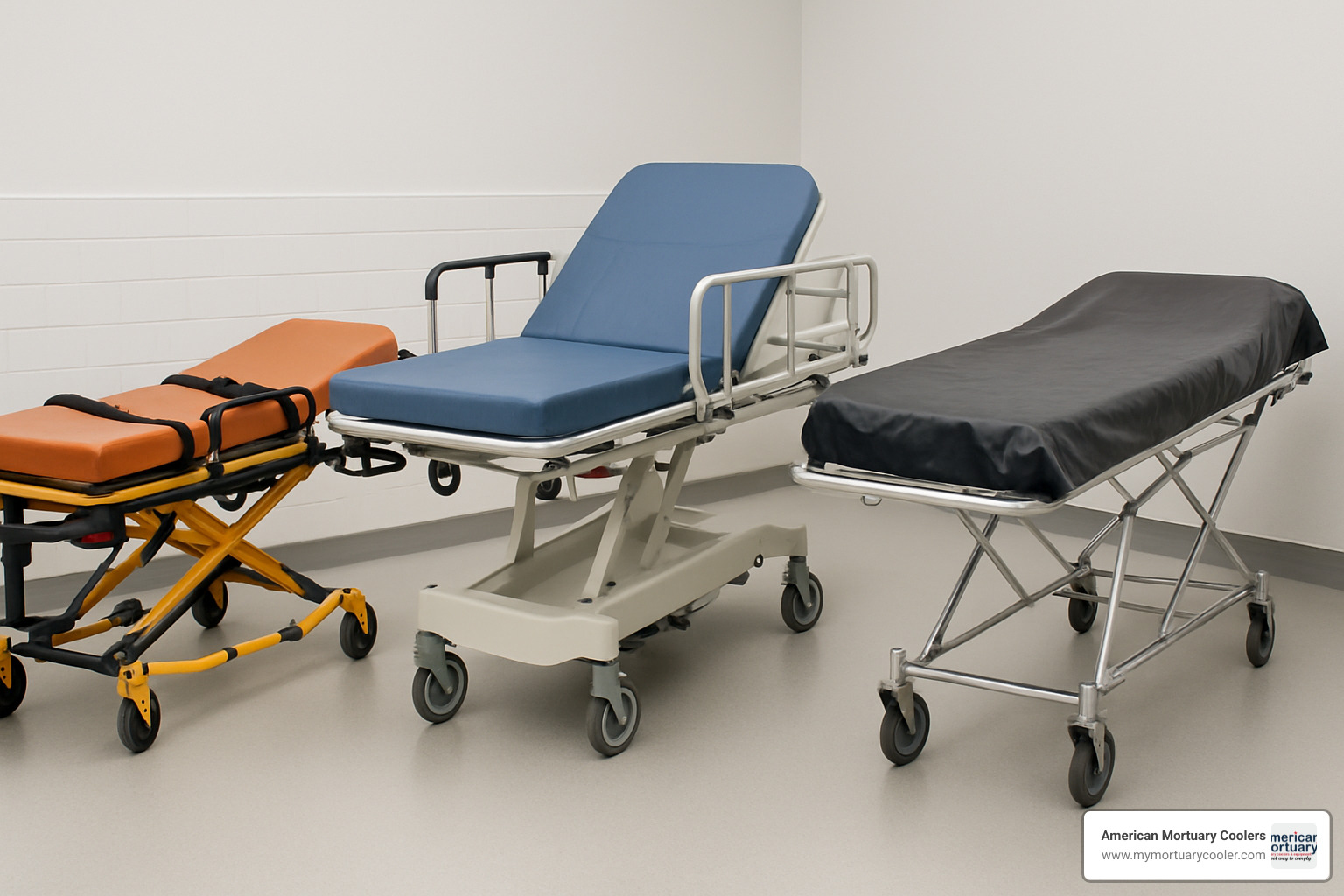
Each type of MEDICAL STRETCHER has evolved through decades of real-world use, with designs continuously refined to better serve patients and caregivers throughout the entire care continuum. For a deeper dive into the fundamentals, check out our Medical Stretchers 101: Everything You Need to Know guide.
Anatomy, Materials & Safety Features
When you look at a MEDICAL STRETCHER, what you're really seeing is years of engineering designed around patient and caregiver safety. These aren't just wheeled beds – they're sophisticated transport systems where every component matters.
Modern stretchers blend lightweight materials with impressive strength. Aluminum alloys help keep the weight manageable for caregivers while providing sturdy support. For environments where durability is paramount (like our mortuary stretchers), stainless steel offers exceptional corrosion resistance and longevity. You'll also find high-impact polymers in areas that need flexibility, and in premium models, carbon fiber delivers that sweet spot of being incredibly strong yet lightweight.
The patient surface – that mattress where comfort matters most – typically features high-density foam wrapped in medical-grade vinyl. These materials aren't just about comfort; they're designed to resist fluids and stand up to rigorous cleaning protocols. At American Mortuary Coolers, we're particularly focused on antimicrobial surfaces for our mortuary stretchers, because maintaining proper hygiene is non-negotiable in that setting.
Safety features have evolved dramatically over the years. Those side rails that fold up and down? They prevent falls during transport. The locking casters ensure the stretcher stays put during patient transfers. Safety straps secure patients during movement, while Trendelenburg positioning allows quick adjustment when dealing with shock or respiratory distress. Many modern stretchers also include radiolucent panels that enable imaging without moving the patient – a huge advancement for both comfort and safety.
Scientific research on patient-handling injuries has driven many of these improvements. Healthcare workers face some of the highest rates of back injuries across all professions, and better stretcher design is part of the solution.
Weight Capacity & Patient Protection
Let's talk weight capacity – it's one of those specifications that truly matters. Standard MEDICAL STRETCHERS typically support between 350-600 pounds, while specialized bariatric models can handle up to 1,200 pounds or even more.
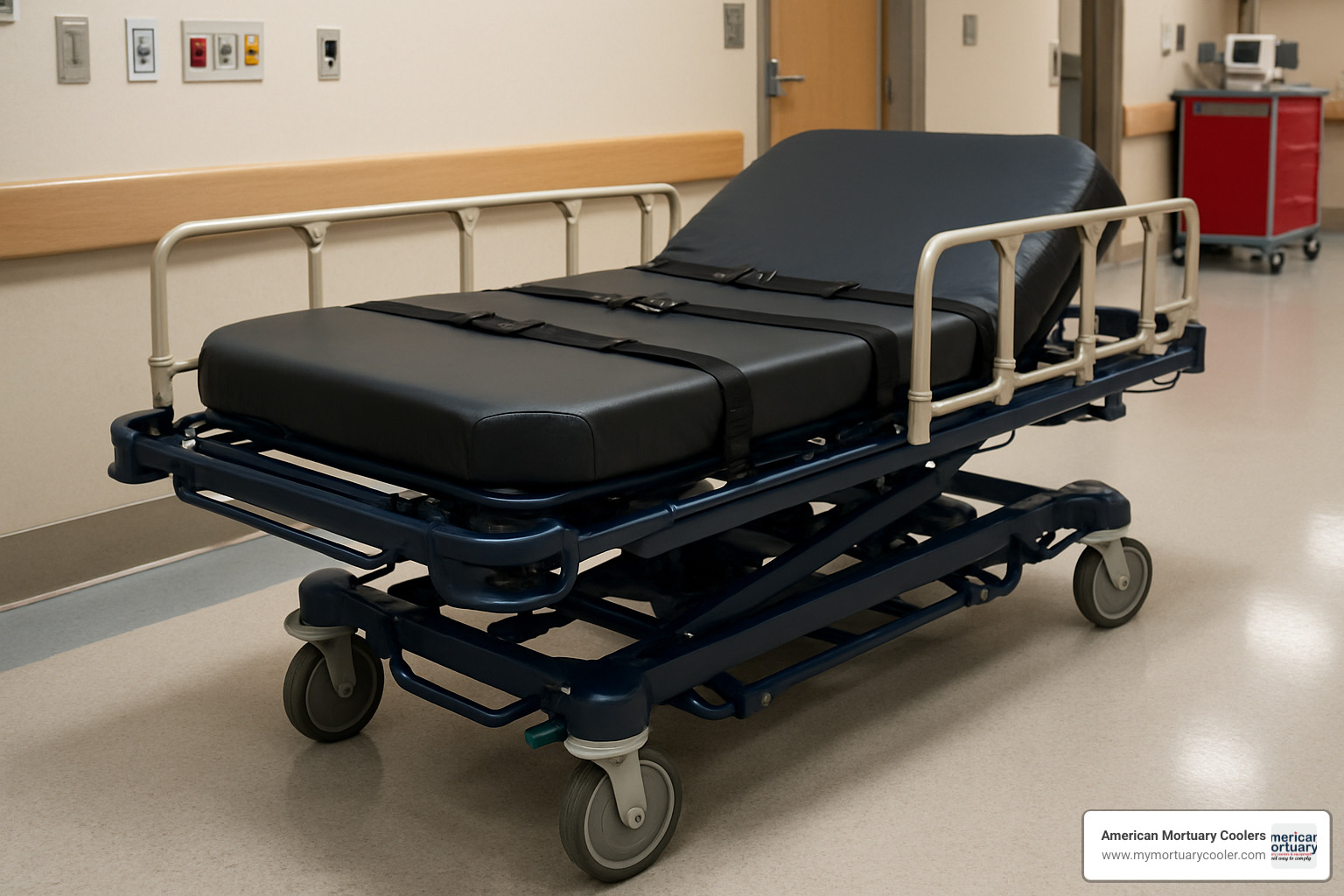
We always recommend choosing a stretcher with room to spare – ideally rated at least 1.5 times the anticipated maximum patient weight. This ensures structural integrity and operational safety throughout the equipment's lifespan. It's not just about whether it can hold the weight today, but whether it can do so reliably for years to come.
Beyond just handling weight, modern stretchers incorporate thoughtful patient protection features. Fall prevention has improved with better side rail designs and lower minimum height positions. Pressure relief comes from multi-density mattresses that reduce the risk of pressure ulcers during longer transports. Patient stabilization systems include everything from head immobilizers to body securing mechanisms.
Infection control has become increasingly important, with seamless surfaces and antimicrobial materials making cleaning more effective. Our mortuary stretchers at American Mortuary Coolers incorporate specialized fluid containment systems – a small but meaningful feature that maintains dignity during post-mortem transport.
Components That Matter
When you're evaluating a MEDICAL STRETCHER, certain components will make a world of difference in daily use.
Height adjustment mechanisms vary widely. Hydraulic pedals allow hands-free height adjustment – caregivers can focus on the patient while their foot does the work. Electric actuators take this further with push-button operation requiring minimal physical effort, though they depend on battery life. Manual cranks remain a budget-friendly option for facilities with limited adjustment needs.
Mobility features directly impact caregiver strain. Ergonomic handles positioned at the right height can reduce back injuries. Fifth wheel technology – an additional center wheel that drops down when in motion – dramatically improves steering in long corridors. Large-diameter casters handle thresholds and uneven surfaces more effectively, making the journey smoother for patients.
Some specialized capabilities are worth highlighting. Imaging compatibility allows X-rays without transferring patients. Articulating backrests provide positioning options for respiratory comfort. Some advanced models even include integrated scale systems that enable weight monitoring without additional patient movement.
While higher-quality components often mean a higher initial price tag, we've consistently found they lead to lower total ownership costs over time. A well-built MEDICAL STRETCHER with quality mechanisms simply lasts longer and requires less maintenance – something we take pride in with all the equipment we provide at American Mortuary Coolers.
Manual, Hydraulic, or Electric? Choosing the Drive System
When it comes to selecting a MEDICAL STRETCHER, one of the most important decisions you'll face is which drive system will best meet your needs. This choice affects everything from how your staff will interact with the equipment to your long-term operational costs.
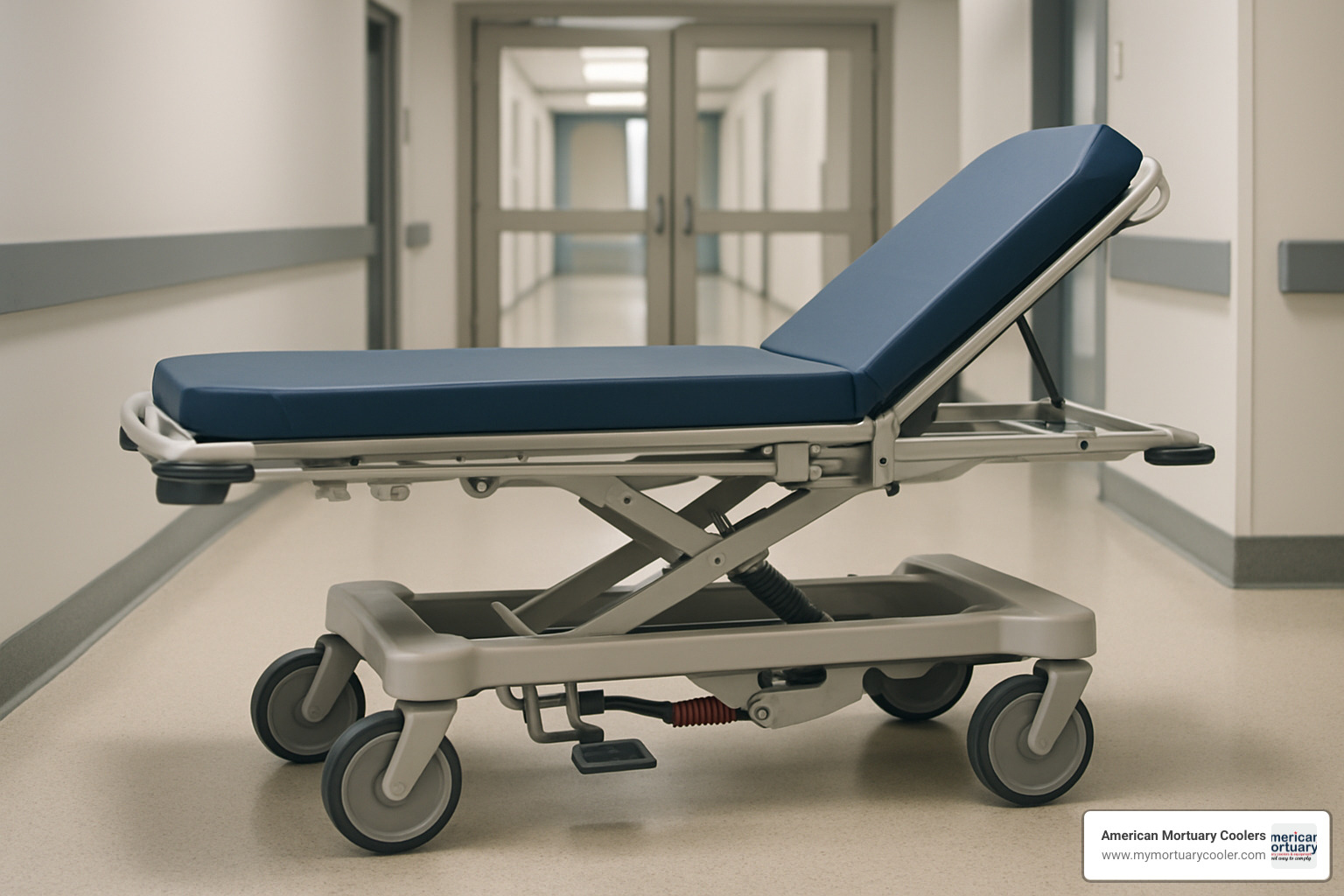
Think of drive systems as existing on a spectrum. On one end, you have the simplicity and affordability of manual stretchers. In the middle, hydraulic systems offer a nice balance. And at the premium end, electric systems provide maximum ease of use and caregiver protection.
Manual stretchers are the workhorses of the industry. They're lighter, more affordable, and have fewer parts that can break down. The trade-off? Your staff will need to use more physical effort to raise, lower, and position these stretchers. For facilities with limited transport needs or those needing reliable backup units, manual stretchers make perfect sense. Just be aware that the physical demands might contribute to staff fatigue and potential injuries over time.
Hydraulic stretchers hit that sweet spot between cost and functionality. With foot-pedal controls, your caregivers can keep their hands free to attend to patients while adjusting height. The pumping action still requires some physical effort, but significantly less than manual models. We've found these to be particularly popular in medium-sized facilities where budget matters but staff wellbeing is also a priority.
Electric stretchers represent the gold standard in caregiver ergonomics. With the push of a button, these stretchers adjust to precise positions with minimal physical effort. While they come with a higher price tag and require battery maintenance, the benefits are substantial – especially in high-volume environments or facilities regularly transporting heavier patients. The reduction in workplace injuries alone often justifies the additional investment.
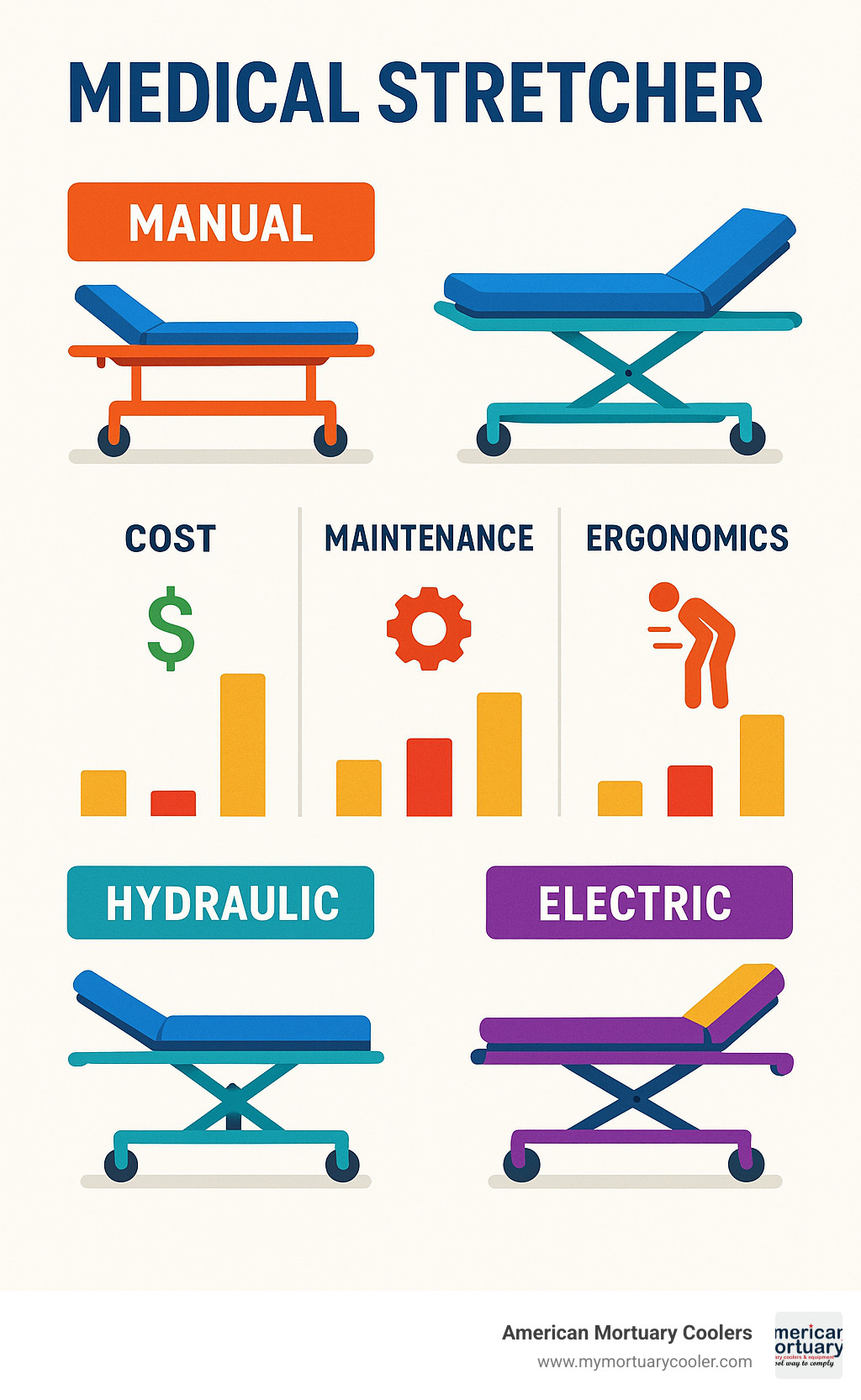
At American Mortuary Coolers, we've watched the industry trend steadily toward hydraulic and electric systems over the years. The reason is simple: the upfront investment pays off through fewer workplace injuries, improved staff satisfaction, and extended equipment lifespan. When your team isn't struggling with equipment, they can focus more energy on compassionate care.
Cost-Benefit Snapshot
Let's talk dollars and sense. MEDICAL STRETCHER pricing varies dramatically based on features and technology:
Basic manual models start around $500 and rarely exceed $2,000. Step up to standard hydraulic stretchers, and you're looking at $2,000-$8,000. Premium electric systems typically range from $8,000 to over $30,000 for advanced features. Need a bariatric model? Add about 30-50% to those base prices. For emergency situations, disposable stretchers are available from just $22 to about $200.
But the sticker price is just the beginning of the story. When calculating the true value of your investment, consider the bigger picture. Electric models may cost more upfront but can dramatically reduce staff injuries – and those worker compensation claims add up quickly. Higher-quality stretchers typically last 7-10 years compared to just 3-5 years for budget models, spreading that initial investment over a longer period.
If budget constraints are a concern, we offer several practical alternatives. Refurbished options can save you 40-60% off new prices while still providing reliable performance. Rental plans offer flexibility for temporary needs or when capital budgets are tight. Many facilities also succeed with a phased implementation approach, replacing their most frequently used units first and gradually upgrading the entire fleet.
At American Mortuary Coolers, we help our customers look beyond the initial price tag to understand the total cost of ownership. Sometimes the most expensive option upfront turns out to be the most economical choice in the long run – especially when you factor in durability, maintenance needs, and the wellbeing of your hardworking staff.
Selecting the Right Stretcher for Your Setting
Finding the perfect MEDICAL STRETCHER for your facility isn't just about budget—it's about matching the right features to your specific environment. Each healthcare setting has unique demands that require thoughtful consideration.
In busy emergency departments, stretchers need to move quickly and position patients rapidly. The ideal ED stretcher features swift height adjustment, excellent mobility in tight spaces, and Trendelenburg positioning for those critical moments when seconds count. X-ray compatibility is also essential to avoid unnecessary patient transfers during diagnosis.
Surgery suites demand precision above all else. Here, MEDICAL STRETCHERS need radiolucent surfaces that won't interfere with imaging, articulating sections for optimal positioning, and rock-solid locking systems that won't shift during delicate procedures. The ability to attach specialized surgical accessories can make all the difference during complex cases.
For our long-term care partners, comfort becomes paramount. These stretchers need superior pressure distribution to prevent tissue damage, lower minimum heights for safer transfers, and simplified controls that work well for staff of all experience levels. Durability matters too—these workhorses see daily use for years.
"We've found that pediatric environments require more than just 'smaller' stretchers," says our equipment specialist. "Kids need specialized securing systems, cheerful design elements to reduce anxiety, and side containment that provides both safety and comfort during what can be frightening experiences."
Bariatric units face unique challenges that standard equipment simply can't handle. MEDICAL STRETCHERS in these settings require substantially reinforced frames, wider patient surfaces, and often powered drive assistance to protect staff from injury. Distributed load casters prevent floor damage while handling heavier weights.
At American Mortuary Coolers, we understand the mortuary transfer environment better than most. Our specialized stretchers feature thoughtful details like fluid containment systems, reinforced weight capacities, and discreet, dignified appearances suitable for family viewing areas. Most importantly, they integrate seamlessly with our cooling and storage systems for efficient workflows during sensitive times.
Key Buying Criteria
When you're evaluating which MEDICAL STRETCHER belongs in your facility, consider these practical factors that will impact daily use:
Mobility needs should top your list—how far will this stretcher travel daily? Will it steer narrow doorways or tight elevator spaces? Does your facility have carpet, tile, or outdoor areas to traverse? The answers affect everything from wheel size to turning radius requirements.
Infection control has never been more important. Look for stretchers with minimal seams where contaminants can hide, surfaces compatible with your facility's disinfection protocols, and removable components that allow thorough cleaning. Some modern options even incorporate antimicrobial materials for added protection.
Regulatory compliance isn't optional. Ensure any MEDICAL STRETCHER you consider meets FDA registration requirements, adheres to IEC 60601 standards for electrical systems, and carries appropriate weight capacity certifications. Your risk management team will thank you later.
Don't overlook accessory compatibility—those IV poles, oxygen holders, and procedure trays aren't universal. Choosing a stretcher that works with your existing accessories (or comes with the ones you need) prevents costly surprises after purchase.
Budget considerations extend beyond the price tag. A quality MEDICAL STRETCHER might cost more initially but save thousands over its lifespan through reduced maintenance, longer service life, and better warranty coverage. We often recommend creating a weighted scoring matrix that balances these factors against your specific needs.
Specialty Add-Ons & Accessories
The right accessories can transform a standard MEDICAL STRETCHER into a specialized care platform custom to your unique requirements.
For improved patient monitoring, consider oxygen tank holders that secure cylinders safely, adjustable IV poles that accommodate multiple pumps, and cardiac monitor shelves that keep vital information visible. Warming mattress systems provide comfort during lengthy procedures, while articulating head positioners help maintain proper airway alignment.
Imaging departments benefit from specialized add-ons like X-ray cassette trays that slide effortlessly under patients, procedure trays that create sterile fields, and fluoroscopy-compatible sections that enable clear visualization. These thoughtful additions eliminate the need to transfer patients between different equipment pieces.
Transport efficiency improves with strategic accessories like multi-position push handles that accommodate staff of different heights, documentation surfaces that keep charts accessible, and integrated scale systems that eliminate separate weighing steps. Some facilities even opt for power-drive assist mechanisms that reduce staff strain during long transports.
For emergency and field applications, consider disposable litters for mass casualty events, all-terrain wheel attachments for outdoor rescues, and specialized restraint systems for secure transport in challenging conditions. These additions can make the difference between adequate response and exceptional care.
Here at American Mortuary Coolers, we've developed specialized mortuary stretcher accessories including dignified coverings that maintain privacy, clear identification systems that prevent errors, and compatibility adapters that ensure our stretchers work perfectly with our cooling and storage solutions. These thoughtful details create seamless workflows throughout the mortuary process, allowing you to focus on providing compassionate service to families during difficult times.
Cleaning, Maintenance & Emerging Trends
Let's face it - keeping your MEDICAL STRETCHER clean isn't just about appearances. It's about patient safety, infection control, and making sure your investment lasts for years to come. At American Mortuary Coolers, we've seen how proper maintenance can extend equipment life by years.
Establishing a consistent cleaning routine makes all the difference. Most manufacturers provide specific guidelines, but here's a general approach that works well for most facilities:
First, remove any visible debris with disposable wipes - working from clean areas toward soiled ones. Then apply your facility-approved disinfectant, paying careful attention to the contact time (that's how long it needs to stay wet to actually kill pathogens). Don't forget those high-touch areas like side rails, handles, and control panels - they're germ magnets! Always let surfaces dry completely before returning the stretcher to service.
Modern sanitizing technologies have come a long way from just "spray and wipe." Many facilities now supplement manual cleaning with UV-C light systems that provide comprehensive surface disinfection. Others use hydrogen peroxide vapor systems that can reach those tricky nooks and crannies. We're even seeing antimicrobial copper alloy surfaces and self-sanitizing nanotechnology coatings becoming more common in premium MEDICAL STRETCHER models.
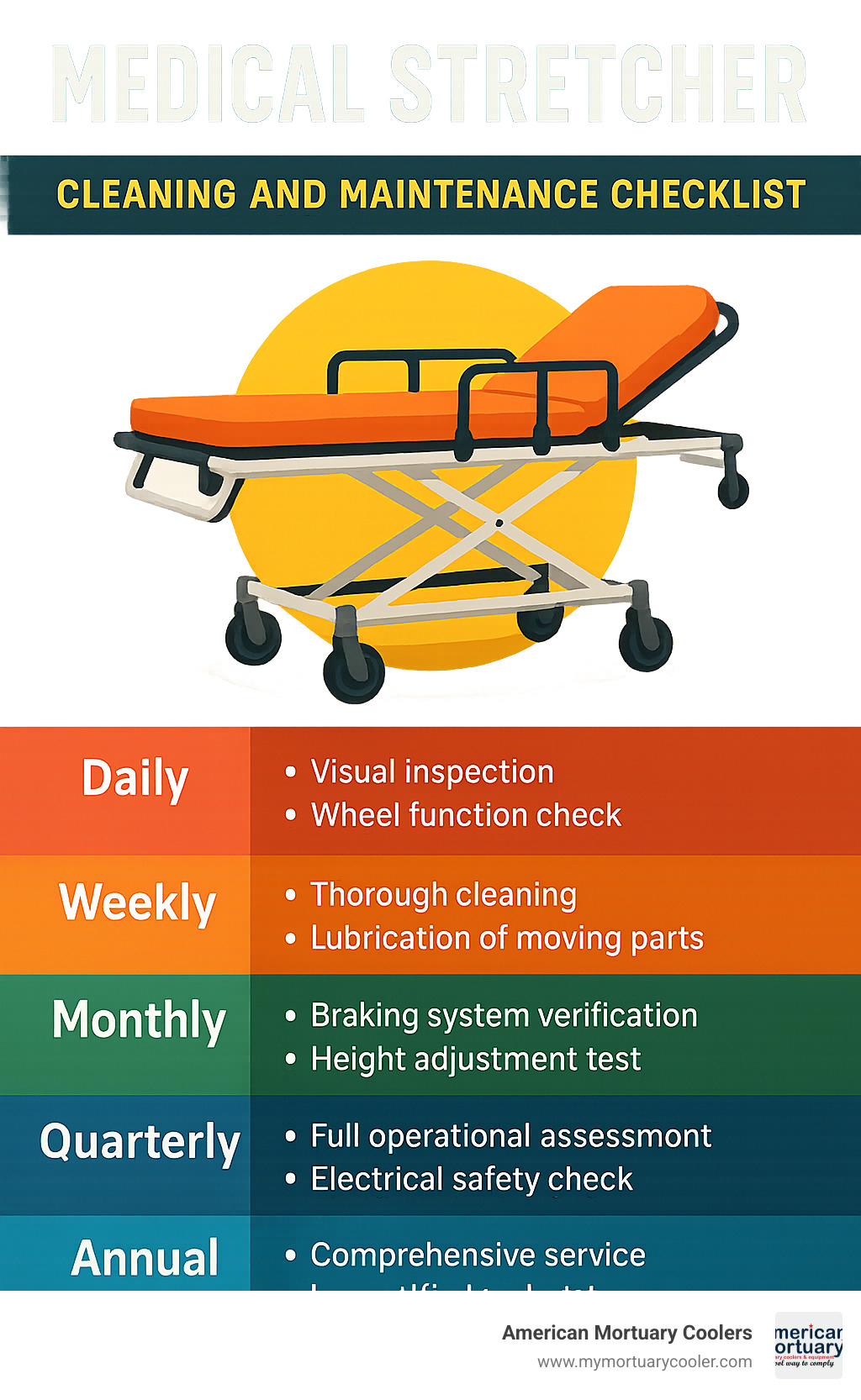
Maintenance isn't just about cleaning, though. A good preventive maintenance schedule keeps your MEDICAL STRETCHER running smoothly and catches small issues before they become big problems. Daily visual checks of wheels, batteries, and basic functions take just moments but can prevent major headaches. Weekly, take time to lubricate moving parts and perform more thorough cleaning. Monthly checks should include testing braking systems and height adjustments. Quarterly, conduct a full operational assessment, and annually, bring in a certified technician for comprehensive service.
The MEDICAL STRETCHER world is constantly evolving with exciting innovations. Internet of Things (IoT) integration is creating "smart stretchers" that can track their location, alert staff to maintenance needs, and even provide usage analytics to improve workflow. Lightweight composite materials are making stretchers easier to maneuver while maintaining their strength and durability.
One of the most welcome trends we're seeing is the development of "zero-lift" technologies - power-assist features that practically eliminate the need for manual lifting. This is a game-changer for reducing workplace injuries among healthcare staff. Telematics systems now allow remote monitoring of battery status, maintenance needs, and utilization patterns, making fleet management much more efficient.
At American Mortuary Coolers, we're particularly excited about integrating smart technology into our mortuary transport systems. These innovations improve tracking, documentation, and workflow efficiency throughout the entire mortuary process - giving funeral directors peace of mind and helping them provide better service to families during difficult times.
Proper care of your MEDICAL STRETCHER isn't just about protecting your investment - it's about creating a safer environment for patients and caregivers alike. A well-maintained stretcher performs better, lasts longer, and ultimately delivers better care outcomes.
Frequently Asked Questions about Medical Stretchers
How often should a stretcher be serviced?
Let's talk about keeping your MEDICAL STRETCHER in top shape. Just like your car needs regular oil changes, stretchers need consistent care to perform reliably when you need them most.
The smartest approach is a tiered maintenance schedule that catches small issues before they become big problems. Start with daily quick checks where your team verifies brakes, side rails, and looks for any visible damage. These take just a minute but can prevent accidents.
Weekly, someone should take a closer look at moving parts and cleaning mechanisms, while monthly checks should verify all functions and safety features are working properly. Quarterly, you'll want more thorough preventive maintenance including lubricating moving parts and making adjustments.
Don't skip that annual comprehensive service by certified technicians! They catch things the rest of us miss.
For hydraulic stretchers, check the fluid levels every six months and plan to replace it every 2-3 years. If you're using electric models, test those batteries quarterly and budget for replacement every 2-3 years depending on how heavily they're used.
Here at American Mortuary Coolers, we always recommend keeping detailed service logs for each stretcher. Not only does this documentation help with regulatory compliance, but it's often required for warranty validation. Many of our customers appreciate our service contracts that take the guesswork out of maintenance scheduling.
What regulations govern stretcher design?
Navigating the regulatory landscape for MEDICAL STRETCHERS can feel like solving a puzzle. These aren't just simple transport devices—they're classified as medical equipment with serious oversight.
In the United States, stretchers typically fall under FDA regulation as Class I or Class II medical devices. This means manufacturers must register with the FDA and comply with Quality System Regulations—a framework that ensures consistent quality and safety.
International standards matter too. The IEC 60601 standard covers electrical safety for medical equipment, while CE marking is essential for any stretcher sold in European markets. Quality management systems typically follow ISO 13485, and healthcare facilities must consider NFPA 99 code requirements.
Ambulance stretchers face even more specific requirements. They need to meet KKK-A-1822 federal specifications, NFPA 1917 standards for automotive ambulances, and in Europe, the BS EN 1865 specifications.
At American Mortuary Coolers, we ensure our mortuary stretchers comply with all relevant regulations while addressing the specialized needs of funeral service professionals. We maintain comprehensive documentation of regulatory compliance to support our customers during accreditation processes. It's one less thing for you to worry about.
Can one stretcher fit multiple departments?
The dream of a single, do-it-all MEDICAL STRETCHER is appealing—especially when you're watching your budget. While truly universal stretchers are rare, modular designs with interchangeable components can effectively serve multiple functions.
The secret to multi-department versatility lies in specific features. Look for stretchers with modular accessory rails that accept various attachments, adjustable height ranges for different transfer scenarios, and convertible configurations that switch between chair and flat positioning. Removable components and universal docking compatibility also expand functionality across departments.
However, versatility comes with trade-offs. Multi-purpose stretchers typically cost more upfront, require more staff training due to their complexity, and may not perform specialized functions quite as well as dedicated equipment. They're often heavier because of additional mechanisms, and maintenance can be more involved.
We've found through working with our customers at American Mortuary Coolers that specialized equipment typically performs better for dedicated tasks. That said, facilities with tight spaces or budget constraints can benefit tremendously from carefully selected multi-purpose transport solutions. We love sitting down with customers to evaluate their workflow patterns and determine whether specialized or multi-purpose equipment will better serve their unique needs.
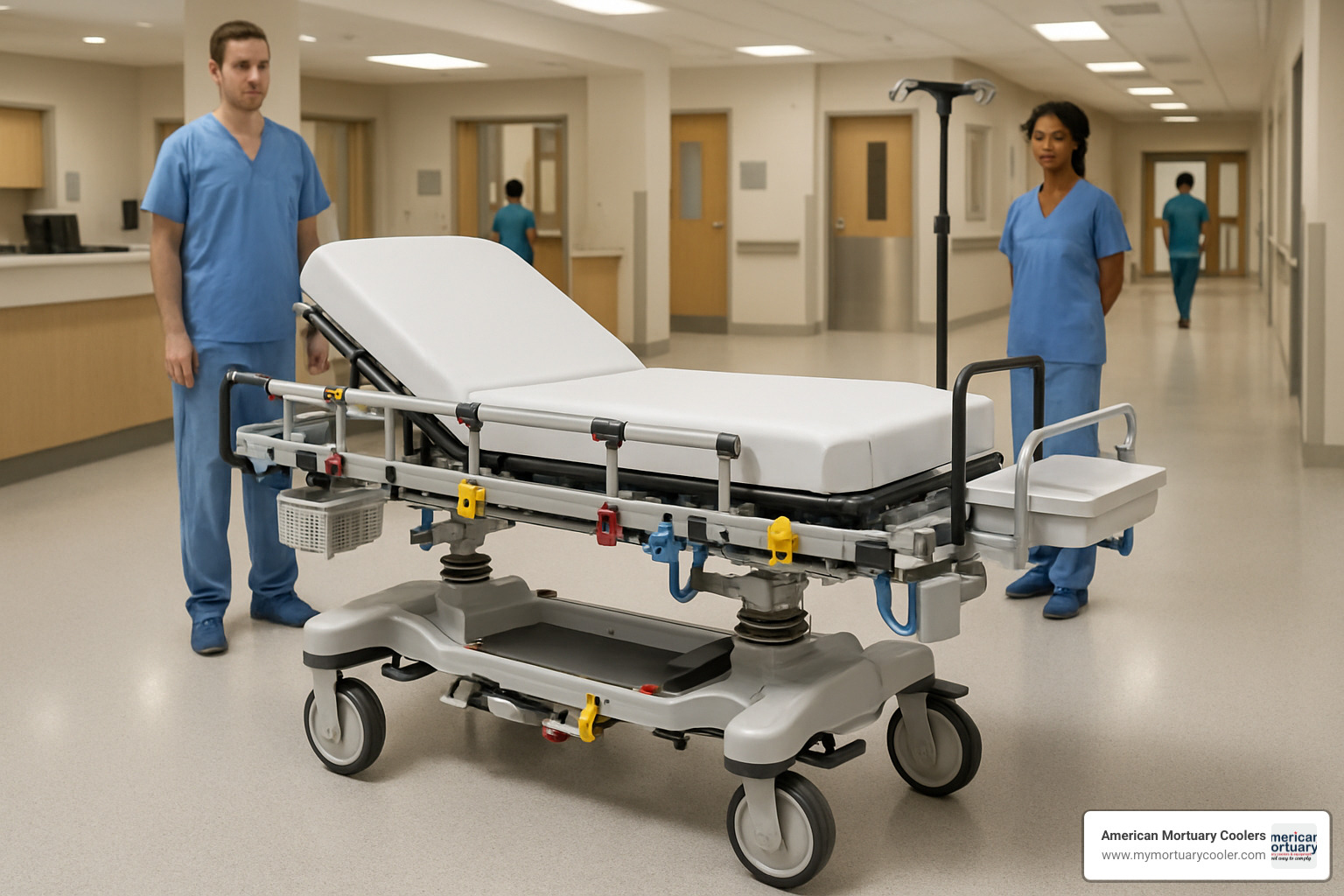
The bottom line? One stretcher can work across departments, but whether it should depends entirely on your facility's specific needs and workflows.
Conclusion
Choosing the perfect MEDICAL STRETCHER feels a bit like finding the right pair of shoes – it needs to fit just right for your specific needs. Throughout this guide, we've walked through the many considerations that go into this important decision, from patient requirements and caregiver ergonomics to facility specifications and budget realities.
At American Mortuary Coolers, we've spent over a decade helping healthcare professionals and funeral directors steer these choices. Based in the heart of Tennessee, we've built our reputation on creating custom mortuary coolers and related equipment that work harmoniously with stretcher systems. Our customers appreciate that our durable solutions are delivered directly to their doorstep anywhere in the lower 48 states – no middleman, no hassle.
A MEDICAL STRETCHER isn't just another piece of equipment; it's a crucial link in providing dignified, safe care. When a busy emergency department needs to quickly transport a critical patient, when a surgical team requires precise positioning, or when a funeral director must provide respectful transfer services for a family's loved one – the right stretcher makes all the difference.
We often tell our customers that while the sticker price matters, it's just one piece of the puzzle. The true value comes from considering the total cost of ownership – including maintenance requirements, durability factors, and the ergonomic benefits that prevent staff injuries. A quality stretcher that lasts for years without issues often proves more economical than repeatedly replacing cheaper alternatives.
I've personally seen how the right equipment can transform a facility's operations. One funeral home we worked with was struggling with an aging fleet of basic stretchers that were causing back injuries among their staff. After upgrading to properly designed mortuary stretchers that integrated with their cooling systems, they reported not only improved staff satisfaction but also improved presentation for family viewings – a detail that made a meaningful difference for grieving families.
Whether you're equipping a hospital department, upgrading an ambulance fleet, or enhancing mortuary operations, investing thoughtfully in transport equipment creates ripple effects throughout your organization – improving safety, efficiency, and the dignity with which you serve.
We'd love to help you find the perfect MEDICAL STRETCHER solution for your unique needs. Our team of friendly experts is just a phone call away, ready to provide personalized recommendations based on your specific requirements. After all, in our business, it's all about providing the right support – both for you and for those in your care.
For more information about how our equipment solutions can improve your facility's capabilities, please reach out through our website at More info about our equipment solutions.
















